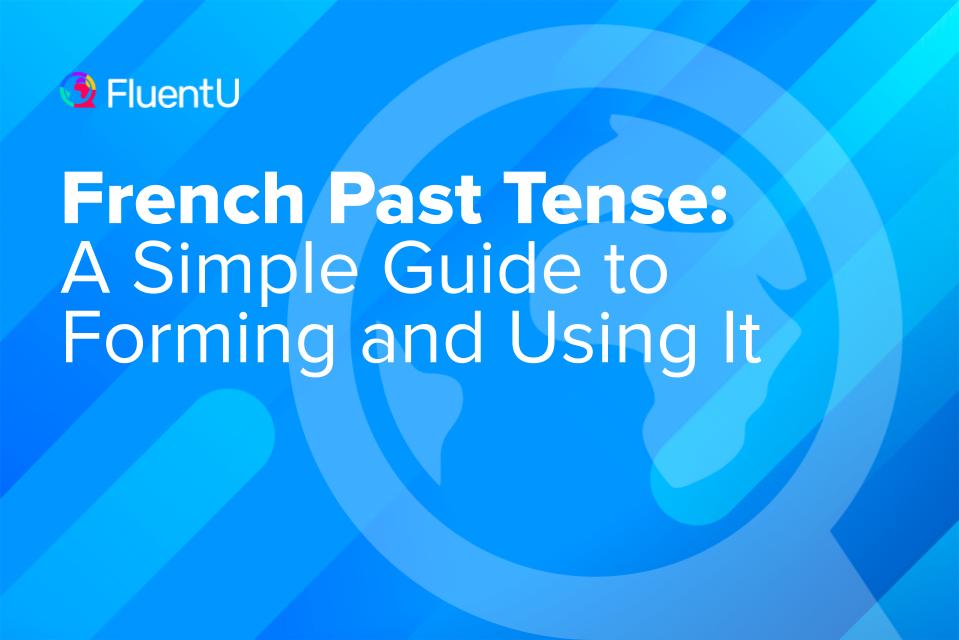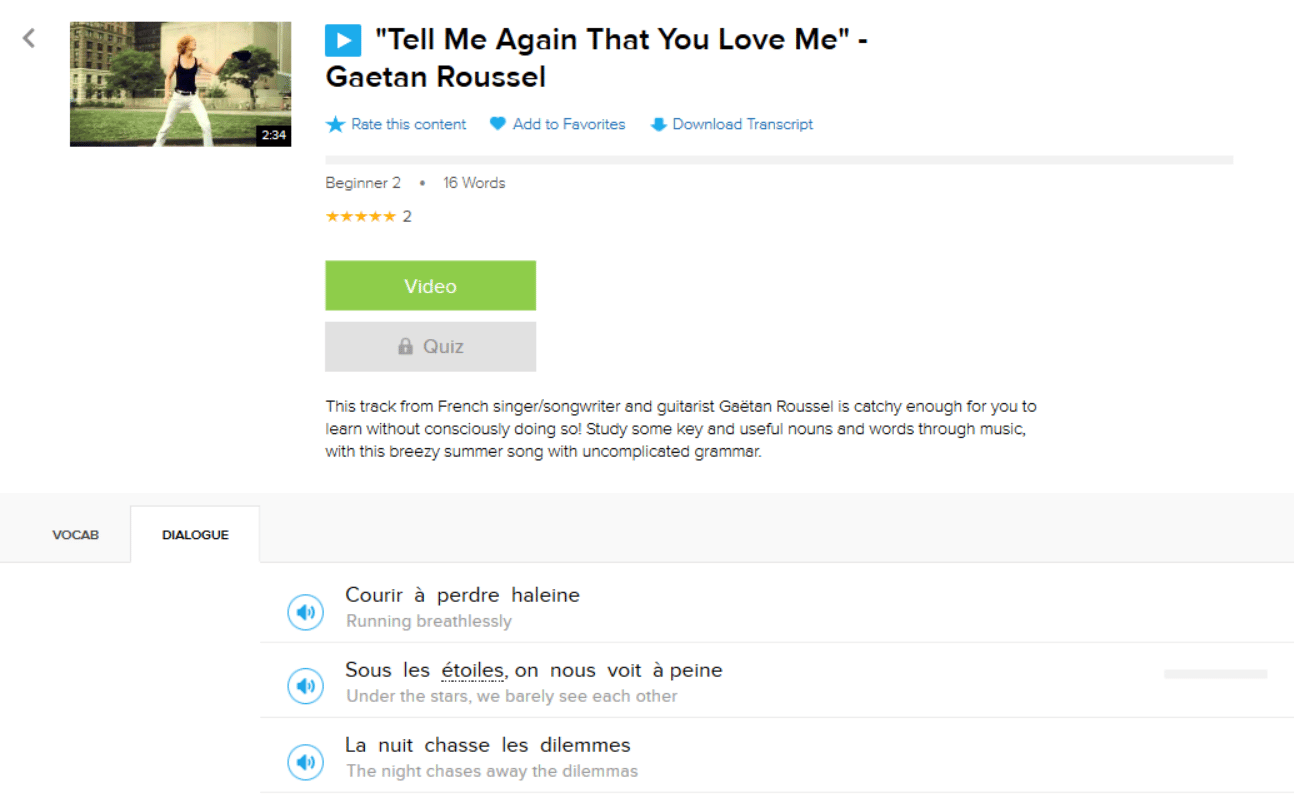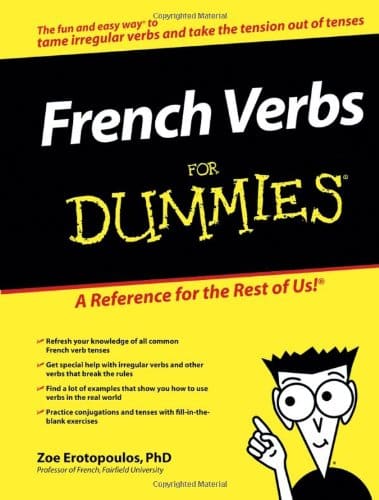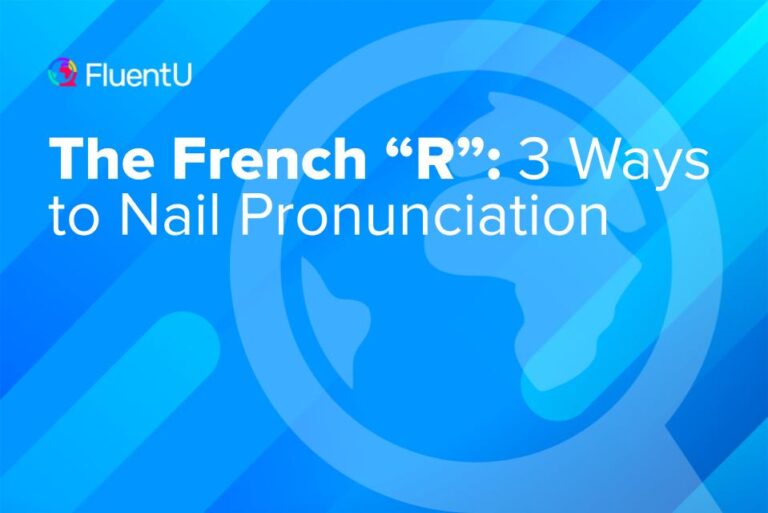French Past Tense: A Simple Guide to Forming and Using It

The French past tense passé composé is used to talk about things that have already happened. But there are actually four main French past tenses, each used for different time frames in the past.
In this article, I’ll explain everything you need to know to form and use the French past tense.
Download: This blog post is available as a convenient and portable PDF that you can take anywhere. Click here to get a copy. (Download)
How to Form le Passé Composé
Le passé composé is a compound verb tense and it’s made of two parts.
The first is called the auxiliary verb, or helping verb, and it’s the conjugated form of either avoir or être.
The second is called the past participle, which is a verb form that appears in both English and French. In English, the past participle typically ends in “-ed,” as in “walked” or “opened.” In French, the typical past participle endings are -é, -i and -u.
In English and French alike, the past participle can denote a past or completed action (e.g., “Jean opened the door”), but that’s not all. It can also be used to form compound tenses (“Jean had opened the door”) in the passive voice (“The door was opened by Jean”) and sometimes as an adjective (“The opened door allows cold air to enter the room”).
It’s created by replacing the last two letters of the verb’s infinitive.
Using avoir
You’ll need to conjugate your helping verb to match whoever is being spoken about. Here are the conjugations for avoir in case you need a refresher:
J‘ai
(I have)
Tu as
(You have)
Il a
(He/she has)
Nous avons
(We have)
Vous avez
(You have)
Ils ont
(They have)
Using être: VANDERTRAMP verbs
Most verbs conjugate with avoir, but all reflexive verbs—ie. se laver (to wash oneself), se figurer (to imagine)—conjugate with être. There are also a number of verbs called dr. mrs. Vandertramp verbs that conjugate with être.
Here’s a list of the most common être verbs, their past participles and their definitions. Just remember the fun little mnemonic: DR. & MRS. VANDERTRAMP.
Devenir (to become) – devenu*
Revenir (to return) – revenu*
Monter (to go up, ascend) – monté
Rester (to stay) – resté
Sortir (to come out) – sorti
Venir (to come) – venu*
Aller (to go) – allé
Naître (to be born) – né*
Descendre (to go down, descend) – descendu
Entrer (to enter) – entré
Rentrer (to return) – rentré
Tomber (to fall) – tombé
Retourner (to go back) – retourné
Arriver (to arrive) – arrivé
Mourir (to die) – mort*
Partir (to leave) – parti*
You may have noticed that with the exception of naître and mourir, all of these verbs are movement verbs: going, coming, arriving, leaving, etc. Keep this in mind when you’re rattling your brain to remember which helping verb you need.
Rejoice, because with a few exceptions, these être verbs are regular. Those with asterisks are the irregular ones you’ll need to remember.
Verbs that take être involve one more step. After conjugating with your helping verb, you add your past participle in the mix, just like before, but this time, you agree the past participle with your subject:
- Elle est allée (She went)
- Nous sommes venus (We came)
- Elles sont restées (They stayed)
Luckily, the endings are pretty straight forward:
- –e at the end of the past past participle for feminine singular
- no ending for masculine singular
- –s at the end of masculine plural
- –es at the end of feminine plural
Adding the past participle
Add the past participle. To figure out what the past participle is, follow these (regular) rules. (We’ll get to irregular verbs later.)
- For -er verbs like nager (to swim), manger (to eat), jouer (to play), etc. drop the -er and replace with -é to make the past participle: nagé, mangé, joué.
- For -ir verbs like finir (to finish), réfléchir (to think), choisir (to choose), etc. drop the -ir and replace with –i to make the past participle: fini, réfléchi, choisi.
- For –re verbs like perdre (to lose), attendre (to wait), répondre (to respond), etc. drop the –re and replace with -u to make the past participle: perdu, attendu, répondu.
Examples of the passé composé
So our perfect tense equation is:
Part A (helping verb) + Part B (past participle) = C (the perfect tense)
If you do your math right, it should look like this:
- J’ai mangé. (I ate.)
- Tu as nagé. (You swam.)
- Elle a réfléchi. (She thought.)
- Nous avons perdu. (We lost.)
- Vous avez attendu. (You waited.)
- Ils ont répondu. (They responded.)
- Elles ont joué. (They played.)
- Je me suis lavé. / lavée (I washed myself.)
- Nous avons parlé. (We spoke.)
- Ils/Elles ont vendu. (They sold.)
French Past Compound Tenses
In French, tenses and moods are either simple or compound.
Simple tenses are comprised of only one conjugated verb, whereas a compound tense is comprised of an auxiliary of either être (to be) or avoir (to have) along with the past participle.
Passé composé (compound past)
In French, the compound past is used to refer to completed actions in the past. It’s often used in conjunction with the imparfait (imperfect), which describes actions in the past that are either incomplete or ongoing.
In the compound past, the auxiliary verb is conjugated in the present tense:
- J’ai mangé un biscuit. (I ate a cookie.)
- Je suis allée au cinéma. (I went to the movie theater.)
You’re already familiar with this one thanks to the detailed description above!
Plus-que-parfait (pluperfect)
The pluperfect is used to refer to an action in the past that took place before another action in the past. The latter occurring action can either be implied or explicitly stated.
In the pluperfect, the auxiliary verb is conjugated in the imperfect.
- J’avais mangé un biscuit avant de faire à manger . (I had eaten a cookie [before making something to eat].)
- J’étais allé au cinéma avant de manger . (I had gone to the movie theater [before eating].)
Passé antérieur (anterior past)
The anterior past is a literary version of the pluperfect. It’s used when an action in the past is finished before another action (also in the past) took place.
In the anterior past, the auxiliary verb is conjugated in the passé simple (simple past).
- Quand j’eus fini de ranger la maison, je sortis prendre l’air. (When I had finished tidying up the house, I went outside to get some fresh air.)
- Elle eut mangé tout le gâteau avant que je n’arrive à la fête. (She had eaten all the cake before I arrived at the party.)
Other Uses for the French Past Participle
Forming the French passive voice
Voice refers to the relationship between the subjects and verbs in a sentence. In French and English alike, there are two voices: active and passive.
In the active voice, the subject performs the action expressed by the verb, while in the passive voice, the action being referred to by the verb is done to the subject by an agent.
The passive voice is formed with the appropriately conjugated être (to be) + the past participle of the verb. The past participle must agree in gender and number with the noun to which it refers.
- Le travail est fait par Marie. (The work is done by Marie.)
- Les lettres sont écrites par Thomas. (The letters were written by Thomas.)
Forming adjectives in French
The past participle can also be used to form adjectives. The adjective can either be formed by the past participle alone or with the verb être (to be).
The past participle must agree in gender and number with the noun to which it refers.
- Michel est un acteur connu de tout le monde. (Michel is an actor known by everyone.)
- Déçue, Charlotte pleure. (Disappointed, Charlotte cries.)
How to Use Reflexive Verbs in the Past Tense
Reflexive verbs always take être, and they agree with their subject, just like the DR. & MRS. VANDERTRAMP verbs. Let’s take a gander at some examples:
- Je me suis lavé. / lavée (I washed myself.)
- Tu t’es amusé. / amusée (You had fun.)
- Il s’est habillé. (He got dressed.)
- Elle s’est levée. (She woke up.)
- Nous nous sommes fâchés. (We got angry.)
- Vous vous êtes rasés. (You have shaved.)
- Ils se sont soûlés. (They got drunk.)
- Elles se sont maquillées. (They put makeup on.)
Essentially, it’s just like the DR. & MRS. VANDERTRAMP verbs, but with your little reflexive pronoun tagging along before the helping verb. (Remember that the reflexive pronoun always matches the subject.)
But there’s a catch: If the reflexive verb is followed by a body part, the past participle does not agree. For example:
- Je me suis lavé les bras. (I washed my arms.)
- Elle s’est cassé les jambes. (She broke her legs.)
How to Practice the French Past Tense
Online exercises
You can find many places to practice the French past tense online. Here are some of our favorites:
- Conjuguemos has fun exercises for different French past tenses. You can set how long you want to practice, then compelte conjugations of the verbs you’re presented on. The different categories makes it easy to focus your practice on specific areas of concern.
- Colleges like the University of Texas at Austin and Columbia University offer free online quizzes where you can practice verb conjugations.
- ToLearnFrench has very simple and easy-to-follow descriptions of the different past tenses, followed by straightforward fill-in-the-blank exerises for each.
- Lingolia has free exercises that mix multiple-choice and fill-in-the-blank questions for a wider ranger of practice.
It’s also very helpful to see the past tense in practice. The FluentU program could help you here, through hundreds of authentic French-language videos like movie clips and music videos.
FluentU takes authentic videos—like music videos, movie trailers, news and inspiring talks—and turns them into personalized language learning lessons.
You can try FluentU for free for 2 weeks. Check out the website or download the iOS app or Android app.
P.S. Click here to take advantage of our current sale! (Expires at the end of this month.)
Practice books
Reading is the best way to see past tenses in action. Doing so helps to identify what past tenses look like, when and why they’re used and what their differences are.
Also, there are a good number of books that focus only on conjugating French verbs. Check these out for some guided practice:
- “501 French Verbs” tackle all of the most common irregular verbs to help you with those tricky exceptions to the rules.
- “Dummies Guide to French Verbs“ breaks down the complex world of French past tenses in a straightforward way.
- This book from the “Practice Makes Perfect” series focuses specifically on the French past tense. It explains the different past tenses and offers many examples and opportunities to practice the topic.
The perfect tense can often be a struggle, but it’s an important one to master. Once you have it down, you can breeze through the other compound tenses.
But hey, don’t stop here. There are other ways to speak in the past tense in French, and don’t forget the future. You’ll need them to become a mad time traveling scientist.
Download: This blog post is available as a convenient and portable PDF that you can take anywhere. Click here to get a copy. (Download)
And one more thing...
If you like learning French on your own time and from the comfort of your smart device, then I'd be remiss to not tell you about FluentU.
FluentU has a wide variety of great content, like interviews, documentary excerpts and web series, as you can see here:

FluentU brings native French videos with reach. With interactive captions, you can tap on any word to see an image, definition and useful examples.

For example, if you tap on the word "crois," you'll see this:

Practice and reinforce all the vocabulary you've learned in a given video with learn mode. Swipe left or right to see more examples for the word you’re learning, and play the mini-games found in our dynamic flashcards, like "fill in the blank."

All throughout, FluentU tracks the vocabulary that you’re learning and uses this information to give you a totally personalized experience. It gives you extra practice with difficult words—and reminds you when it’s time to review what you’ve learned.
Start using the FluentU website on your computer or tablet or, better yet, download the FluentU app from the iTunes or Google Play store. Click here to take advantage of our current sale! (Expires at the end of this month.)









